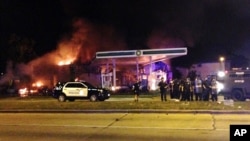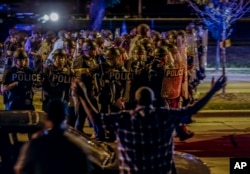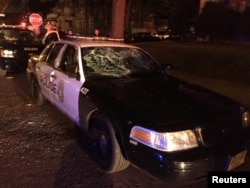For Randy Jones, a community activist in the Milwaukee district of Sherman Park, the rioting that took place in his neighborhood over the weekend was inevitable.
By most any socioeconomic measure, Milwaukee's majority black neighborhoods lag far behind the white, a trend that has grown more acute since the deindustrialization of the 1980s.
So when police shot dead an armed black man after stopping his car for "suspicious activity," tempers ran out of control and parts of the city burned.
Gunfire erupted on Saturday and Sunday nights. Protesters hurled bottles and bricks, torched businesses, and damaged squad cars. At least eight officers have been injured and more than 30 people arrested.
"When you hold a person down so long, they are eventually going to fight back," said Jones, who recently ran for election to the city government but lost. "It was going to happen eventually, it was just a matter of when."
Jones said when he was growing up in the 1970s and '80s, he had a job each summer. Now teenagers, especially young black men, have no income potential and too much idle time.
"They have no hope at all," he said.
By some measures, Milwaukee is the most segregated city in America. The Brookings Institution think tank last December ranked the segregation of cities on a scale of zero to 100 using U.S. Census Bureau data. Milwaukee came in first with a score of 81.
Almost 40 percent of black males in Milwaukee between ages 24 and 54 lack a job, a rate four to five times higher than for whites, said Marc Levine, founding director of the University of Wisconsin Milwaukee's Center for Economic Development.
Interstate highways create borders between impoverished neighborhoods and more affluent areas. Black Milwaukee districts are interspersed with vacant lots and abandoned, blighted houses. The typical hangout for young black men is outside small corner grocery stores where they socialize and become themselves targets of violent crimes.
Sherman Park, where the rioting took place, was once the home of Milwaukee's black middle class but today more than 30 percent of its people live in poverty, Levine said.
Police tensions with African-Americans date at least to the reign of former Police Chief Harold Breier, who opposed the civil rights movement in the 1960s.
The Milwaukee Police Department voluntarily placed itself under federal review following the largely peaceful protests that resulted from the police shooting death of Dontre Hamilton, a mentally ill, unarmed black man in 2014.
An internal report charting data from 2005 to 2014 showed police responded to life-threatening situations within 8.4 minutes in District 2 on the predominantly white south side but took 15 minutes to respond in District 7 on the largely black north side.
Following Ferguson and Baltimore
Milwaukee is the latest American city to be gripped by violence in response to police killings of black men following social outbursts in places such as Ferguson, Missouri, in 2014 and Baltimore last year.
"In a general sense they're connected in the same way they were connected in Baltimore and Ferguson," Levine said. "It's fair to say those systemic inequalities and long history of police department abuses condition the environment so that it's an ongoing powder keg that can erupt at any point."
Mayor Tom Barrett acknowledged poverty contributed to the social unrest but underscored the need to restore order to be able to attract investment.
"In the long term, we know we have to have more jobs in the community. We know there has to be more investment, and you'd have to be crazy to think that this activity [rioting] is in any way helping," Barrett told a news conference on Monday.
Reggie Jackson, chairman of America's Black Holocaust Museum in Milwaukee, said young blacks "feel like they are stuck in this bubble" without any escape, and that misguided investment has failed to provide needed jobs.
He cited the construction of a new basketball arena for the Milwaukee Bucks that has been partly funded with $250 million of taxpayer money.
"That money could have been used in these poor parts of Milwaukee to improve the conditions of the neighborhood," Jackson said. "People feel that it is a slap in the face."










